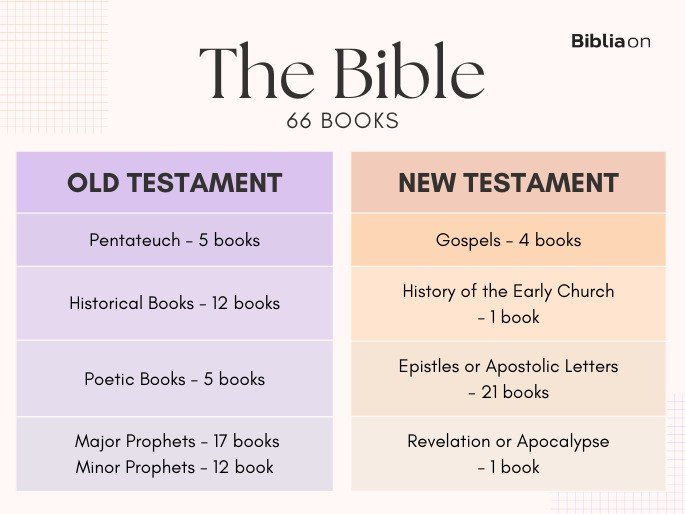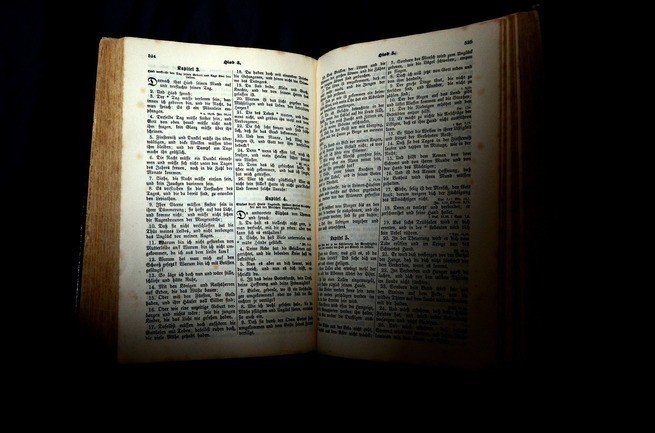The Bible is a collection of 66 books, written between 1500 - 1400 BC and 100 AD. The Holy Bible is divided into two main parts: the Old Testament - or Hebrew Bible - composed of 39 books, and the New Testament, which gathers 27 books. Within these two parts, it also contains 8 groups of books, as can be seen below. Having a Bible is like having a library in your hands!
The word 'Bible' is the plural of the Greek word biblos, which means 'book'. The word also refers to the city of Lebanon called Biblos - which is now called Jbeil - where papyrus was produced and traded in ancient Greece.
All biblical texts were originally written in Hebrew and Greek, with few parts in Aramaic. Each book was written and composed at different times, being brought together in the early centuries of the Christian church.
How the Bible was Divided and Organized
The Bible was not organized entirely in chronological order; the books were organized prioritizing a narrative order. If the books were organized solely in chronological order, the Book of Job would precede the Book of Genesis!
The Bible is divided into 2 major blocks: the Old Testament and the New Testament. The word 'testament' means 'covenant.'
- The first block, The Old Testament, talks about the first covenant that God made with humans, the origins of humanity, the history of the people of Israel, and the promise of the coming of the Messiah.
- And then the second block, The New Testament, introduces us to the new covenant which was fulfilled in Jesus, the expansion of the Gospel, and the prophecy of the end times with the return of Christ. The New Testament is a conclusion and continuation of the Old Testament.
In addition to this 'book-by-book' narrative, the Bible can also be grouped by literary styles, namely: the Pentateuch, the Historical Books, the Poetic Books, the Major Prophets, the Minor Prophets, the Gospels, the History of the Early Church, the Epistles - or Letters - and Revelation or Apocalypse.
See the organization of the Bible in the table and the list with detailed books below:

Old Testament:
1. Pentateuch
The Pentateuch - from the Greek pentateuchos, which means 'book of five volumes' - consists of the first 5 books of the Bible. These are also part of the Torah, the Book of Law for the Jews. All are arranged in chronological order. They are Genesis, Exodus, Leviticus, Numbers, and Deuteronomy.
2. Historical Books
This set consists of 12 books that tell the story of the people of Israel from the conquest of the Promised Land to the Babylonian exile. The 12 books are also in chronological order: Joshua, Judges, Ruth, I and II Samuel, I and II Kings, I and II Chronicles, Ezra, Nehemiah, and Esther.
3. Poetic Books
5 books are part of this group. They are poems, wisdom literature, proverbs, and songs. They are organized by order of relevance, namely: Job, Psalms, Proverbs, Ecclesiastes, and Song of Solomon.
4. Major Prophets
The prophetic books - totaling 17 - are records of the prophets about the People of Israel. In this group, there is a subdivision - major and minor prophets - organized by order of relevance. The major prophets include 5 books: Isaiah, Jeremiah, Lamentations, Ezekiel, and Daniel.
5. Minor Prophets
This group contains 12 prophetic books. The nomenclature does not mean that one prophet was "greater than the other"; in fact, the definition is related to the length of the literary work. The books of the minor prophets have fewer chapters than the books of the major prophets. They are Hosea, Joel, Amos, Obadiah, Jonah, Micah, Nahum, Habakkuk, Zephaniah, Haggai, Zechariah, and Malachi.
6. Intertestamental Period (or Interbiblical)
This period refers to what was not written, it is precisely the space of time in which nothing was prophesied between the Old and New Testaments. The "years of silence" lasted approximately 400 years.
New Testament:
1. Gospels
The 4 Gospels recount the birth, ministry, death, resurrection, and ascension of Jesus. Of these, 3 Gospels are denominated as synoptic - having the same view - as they respect the same sequence of events. Only the Gospel of John differs from the others by having differences in various details, emphasis, and vocabulary. They are the 4 books: Matthew, Mark, Luke, and John.
2. History of the Early Church
It consists of only one historical book. The book deals with the implementation of the Early Church after the outpouring of the Holy Spirit and the expansion of the Gospel. The book is known as Acts of the Apostles.
3. Epistles or Apostolic Letters
They are apostolic letters addressed to the first churches spread in the ancient world, totaling 21 letters. All the letters are organized chronologically, with the first 13 letters being authored by the Apostle Paul, namely: Romans, I and II Corinthians, Galatians, Ephesians, Philippians, Colossians, I and II Thessalonians, I and II Timothy, Titus, and Philemon. The remaining 8 letters were written by other authors, namely: Hebrews, James, I and II Peter, I, II, and III John, and Jude.
4. Revelation or Apocalypse
The only book that belongs in this category is The Book of Revelation - written by John the Evangelist.
How the Bible was Divided into Chapters and Verses
Originally, the books of the Bible were not divided into chapters and verses. Even Jesus, when quoting the Scriptures, used the expression "it is written," because there was no way to reference them accurately.
Incidentally, the organization of the Bible into chapters and verses occurred at very different times. The division of the Bible into chapters was done first by the English clergyman Stephen Langton in 1227. The organization was based on the Vulgate - the Latin version of the Bible - and later Langton chaptered the Hebrew and Greek versions of the Bible.

The inclusion of verses came centuries later. Santi Pagnini was the first to attempt to organize the Bible into numbered verses in 1527. Despite Pagnini's publication, it was the printer Robert Estienne who created the version used to this day. In 1551, Robert Estienne divided the verses of the Greek version of the New Testament, and in 1555, he completed the division of the Latin version.
The first printed Bible to have chapters and verses was the Geneva Bible, published in 1560 in Switzerland. This Bible used Stephen Langton's chapter division and Robert Estienne's numbered verse organization. To this day, this type of organization of the Bible facilitates our study and reading.
How the Bible was Written
God is the true author of the Bible, it was He who inspired men in the elaboration of each book.
20 Above all, you must understand that no prophecy of Scripture came about by the prophet’s own interpretation of things. 21 For prophecy never had its origin in the human will, but prophets, though human, spoke from God as they were carried along by the Holy Spirit.
2 Peter 1:20-22
According to scholars, about 40 people wrote the different books of the bible over approximately 1600 years stretching from the first to the last writer - from Moses to John the Evangelist. Despite so many books written and few connections between their writers, the Bible proves to be inerrant and infallible.

Regarding the authorship of the biblical books, we can perceive some characteristics:
- An author who wrote a single book - An example is the Epistle of James - Jesus' brother - which was written by himself.
- An author who wrote several books - We have the example of the Apostle Paul who wrote around 13 epistles, much of the New Testament.
- A book with various authors - The Book of Psalms is a compilation of poems that has Solomon, David, Moses, Heman, Ethan, the family of Asaph, and the Korahites among its authors.
- A book with one author and editor - This is the case of the book of Deuteronomy, which is attributed to Moses, but the account of his death at the end of the book suggests that someone edited and complemented the book.
- A book with an unknown author - We have the example of the Letter to the Hebrews, which was previously attributed to Paul and today its authorship is discarded. And the Book of Job - the oldest in the Bible - whose authorship is still unknown.
The Bible is unitary, harmonious, and coherent. It explains itself, proof of how perfect and powerful the words recorded there are.
All Scripture is God-breathed and is useful for teaching, rebuking, correcting and training in righteousness,
2 Timothy 3:16
Only the power of God is capable of accomplishing such a perfect and inexhaustible work.
The books of the Bible were united in a very organic way, occurring in two specific moments: one being the compilation of the Old Testament and the other for the New Testament. As the Old Testament was written, the writings were compiled and recognized as the Word of God. This process extended from the earliest writings of Moses to the last with Haggai, Zechariah, and Malachi. The famous Roman-Jewish historian Flavius Josephus, along with Jewish teachers, understood it this way: God was speaking, even through these last prophets.
Regarding the compilation of the New Testament, the writings of theologians from the early centuries list the accepted books as canonical. Some lists differ, containing one more or one less book, but two lists stand out for containing exactly the books as we have them today: the Thirty-Ninth Pascal Letter of Athanasius, representing the eastern part of the church; and the Council of Carthage, representing the western churches.
These lists were made following certain criteria, such as the common use of the early church, direct or indirect connection with the apostles, and agreement with the doctrines already established by the Old Testament.
The unity, harmony, and coherence of the Bible, from its compilation to its enduring relevance, stand as a 'testament' to its divine inspiration and eternal significance.
More about the Bible:
